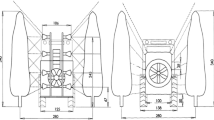Abstract
Agricultural sprayers are utilized in applying pesticides to control pests and diseases in crops. The increase in machine size and a better control system have been associated with increased productivity, improved efficiency and minimized the impact of the chemical on the environment. However, wider booms may contribute to application error due to the difference in speed between the inner and outer boom section when applying in curvilinear passes. Field tests were conducted in three irregular shaped fields with varying terrain using a 36.6-m self-propelled sprayer with a turn compensation technology. The results showed that turning occurred near the grassed waterways, boundaries and end of headlands. The product was applied during turning to 19.0% of Field 1, 17.8% of Field 2 and 22.5% of Field 3. These could have been the percentage of field areas that may receive more or less product if the sprayer was not equipped with turn compensation technology. As expected, the speed difference between the inner and outer boom increases as the radius of turn decreases. The speed difference could translate to an under-application on the outer boom section where the speed is much faster and over-application on the inner boom section where the speed is slower. The application errors from such speed differential could vary from − 48.2 to + 1058.0%, depending on the turning radius. However, the pulse width modulation system implemented duty cycles based on turning speeds, which resulted to a 90.0% application rate uniformity across the field regardless of the travel path during operation.









Similar content being viewed by others
References
Al-Gaadi, K. A., & Ayers, P. D. (1994). Monitoring controller-based field sprayer performance. Applied Engineering in Agriculture, 10(2), 205–208. https://doi.org/10.13031/2013.25843
Ayers, P. D., Rogowski, S. M., & Kimble, B. L. (1990). An investigation of factors affecting sprayer control system performance. Applied Engineering in Agricriculture, 6(6), 701–706. https://doi.org/10.13031/2013.26451
Cox, W. J., Hahn, R. R., & Stachowski, P. J. (2006). Time of weed removal with glyphosate affects corn growth and yield components. Agronomy Journal, 98(2), 349–353. https://doi.org/10.2134/agronj2005.0078
Fabula, J. V., Sharda, A., Luck, J. D., & Brokesh, E. (2021). Nozzle pressure uniformity and expected droplet size of a pulse width modulation (PWM) spray technology. Computers and Electronics in Agriculture, 190, 106388. https://doi.org/10.1016/j.compag.2021.106388
Grisso, R. D., Jasa, P. J., & Rolofson, D. E. (2002). Analysis of traffic patterns and yield monitor data for field efficiency determination. Applied Engineering in Agricriculture, 18(2), 171–178. https://doi.org/10.13031/2013.7782
Luck, J. D., Zandonadi, R. S., Luck, B. D., & Shearer, S. A. (2010). Effects of field shape and size on application errors using manual and automatic boom section control on a self-propelled agricultural sprayer. Paper No. 100961. ASABE. https://doi.org/10.13031/2013.31997
Porter, W. M., Rascon, J. A., Shi, Y., Taylor, R. K., & Weckler, P. A. (2013). Laboratory evaluation of a turn compensation control system for a ground sprayer. Applied Engineering in Agriculture, 29(5), 655–662. https://doi.org/10.13031/aea.29.10075
Reddy, K. N., Hoagland, R. E., & Zablotowicz, R. M. (2000). Effect of glyphosate on growth, chlorophyll and nodulation in glyphosate-resistant and susceptible soybean (Glycine max) varieties. Journal of New Seeds, 2(3), 37–52. https://doi.org/10.1300/J153v02n03_03
Reddy, K. N., & Zablotowicz, R. M. (2003). Glyphosate-resistant soybean response to various salts of glyphosate and glyphosate accumulation in soybean nodules. Weed Science, 51(4), 496–502. https://doi.org/10.1614/0043-1745(2003)051[0496:gsrtvs]2.0.co;2
Sama, M. P., Luck, J. D., & Stombaugh, T. S. (2015). Scalable control architecture for variable-rate turn compensation. Applied Engineering in Agricriculture, 31(3), 425–435. https://doi.org/10.13031/aea.31.10848
Shafagh-Kolvanagh, J., Zehtab-Salmasi, S., Javanshir, A., Moghaddam, M., Dabbagh, A., & Nasab, M. (2008). Effects of nitrogen and duration of weed interference on grain yield and SPAD (chlorophyll) value of soybean (Glycine max (L.) Merrill. Journal of Food, Agriculture & Environment, 6(3), 368–373.
Sharda, A., Fulton, J. P., McDonald, T. P., Zech, W. C., Darr, M. J., & Brodbeck, C. J. (2010). Real-time pressure and flow dynamics due to boom section and individual nozzle control on agricultural sprayers. Transactions of the ASABE, 53(5), 1363–1371. https://doi.org/10.13031/2013.34891
Sharda, A., Luck, J. D., Fulton, J. P., McDonald, T. P., & Shearer, S. A. (2013). Field application uniformity and accuracy of two rate control systems with automatic section capabilities on agricultural sprayers. Precision Agriculture, 14(3), 307–322. https://doi.org/10.1007/s11119-012-9296-z
USDA. (2021). ERS farm income and wealth statistics. Retrieved December 1, 2021, from https://data.ers.usda.gov/reports.aspx?ID=17834#Pb947376daa9a4b6b91294605f2262a48_2_150iT0R0x0
Zandonadi, R. S., Luck, J. D., Stombaugh, T. S., Sama, M. P., & Shearer, S. A. (2011). A computational tool for estimating off-target application areas in agricultural fields. Transactions of the ASABE, 54(1), 41–49. https://doi.org/10.13031/2013.36251
Acknowledgements
The authors would like to extend their deepest gratitude to the Department of Biological and Agricultural Engineering at Kansas State University for providing the essential support to conduct this research. Sincere appreciation is also given to the CNH Industrial Company and Raven Industries, Inc. for providing the sprayer and technical support to accomplish this study. The authors would also like to extend their appreciation to Mr. Kyle Cott for providing the experimental fields used in this research. Lastly, the first author would like to extend his great appreciation to the Central Luzon State University (CLSU) and the Department of Science and Technology-Engineering Research and Development for Technology (DOST-ERDT) of the Republic of the Philippines for supporting his study.
Author information
Authors and Affiliations
Corresponding author
Additional information
Publisher’s note
Springer Nature remains neutral with regard to jurisdictional claims in published maps and institutional affiliations.
Rights and permissions
About this article
Cite this article
Fabula, J.V., Sharda, A. & Mishler, B. Quantification of self-propelled sprayers turn compensation feature utilization and advantages during on-farm applications. Precision Agric 23, 1675–1687 (2022). https://doi.org/10.1007/s11119-022-09903-5
Accepted:
Published:
Issue Date:
DOI: https://doi.org/10.1007/s11119-022-09903-5




